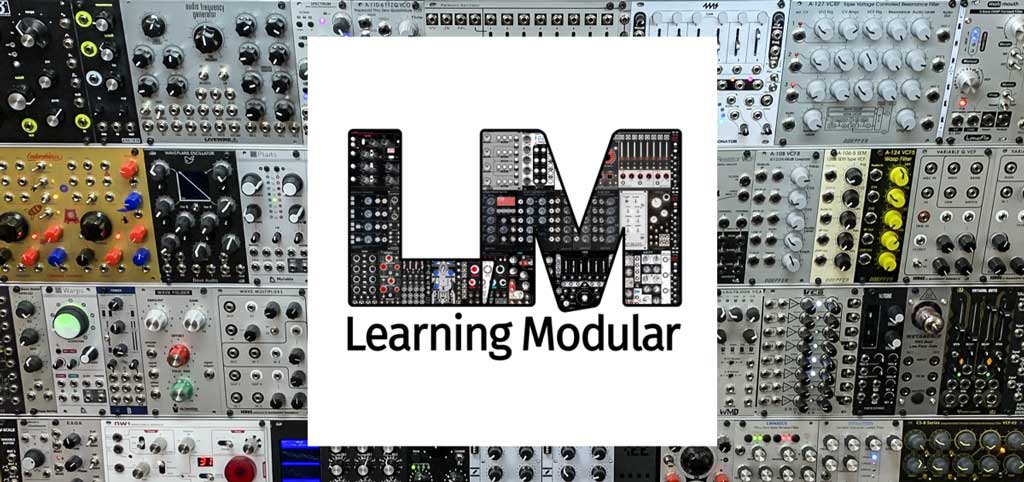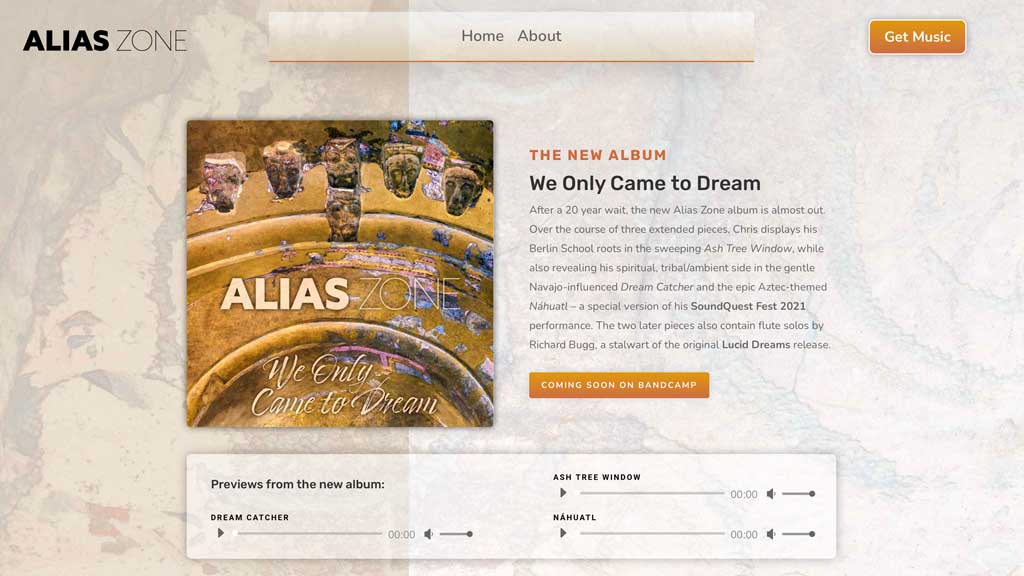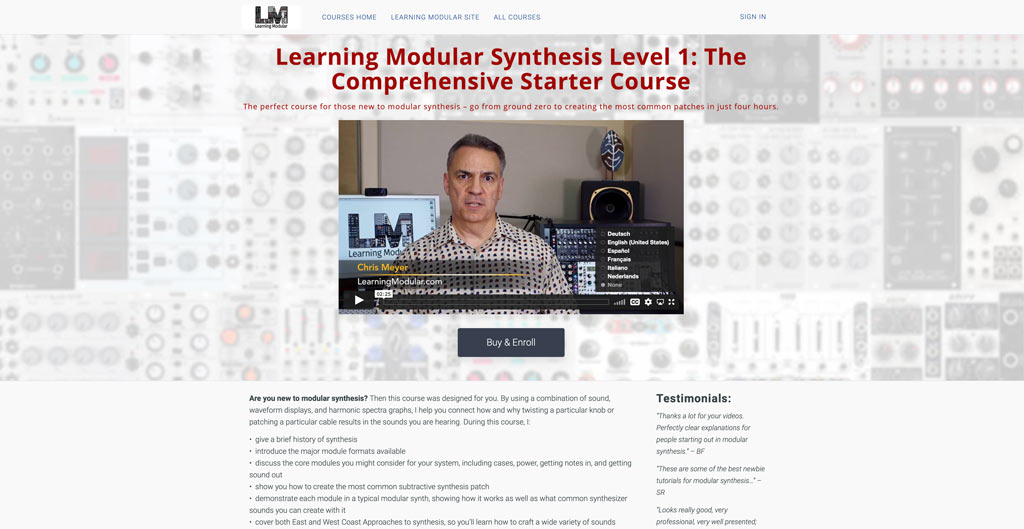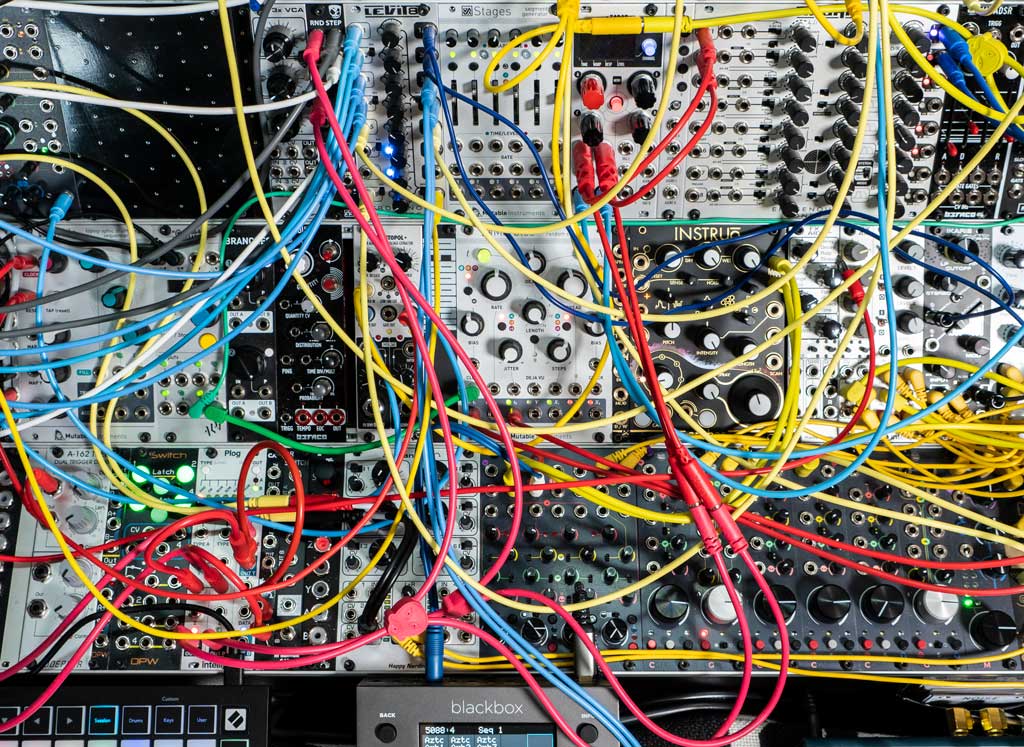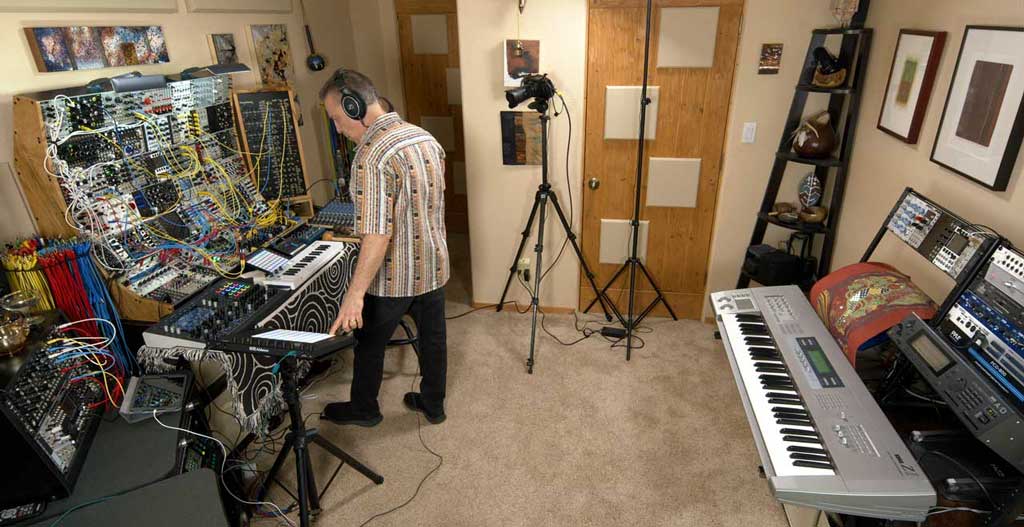What a hectic two months that was! As soon as I was done creating my set for SoundQuest Fest, I went straight into editing, mixing, having mastered, and releasing a new album – my first in 20 years – and then into creating a new web site to support my musical efforts.
That new album – Alias Zone: We Only Came to Dream – marks quite a bit of personal evolution for me. The original Alias Zone album was the result of “being the drummer” in an ensemble (as detailed in the February newsletter). After I got back into modular synthesis a few years ago, my first gig was an Alias Zone reunion, replacing my sample loops from 20 years ago with my percussion-focused modular gigging case. Although I have played a few short solo sets with that case, my focus was still playing with others.
Then the pandemic hit. Unable to do in-person collaborations, for the first time in my life I turned my attention to composing long-form solo works, using all of the tools I had available to me. It started when David Soto of the Colorado Modular Synth Society invited me to compose and play a 20 minute “space music” piece for October Skies last year. It would be an understatement to say that things accelerated quickly from there!
The new album contains a remixed and mastered version of that October Skies performance (Ash Tree Window), as well as my SoundQuest set (Náhuatl) plus a set I did for Resident Electronic Music (Dream Catcher). The album versions of those last two also feature processed flute overdubs by my good friend Richard Bugg, who got me into the whole live performance and improvisational thing when he invited me to be a member of his Cosmic Debris ensemble back in the 1990s.
- featured article: Recording and performance notes on the three tracks that make up my new album.
- new videos & posts: Some patching demonstrations, and a post on improvising.
- course updates: Did you lose your password?
- Patreon updates: A new series on generative patching ideas, and more.
- upcoming events: SoCal Synth Society Summit in May, plus I’m looking for more gigs…
- one more thing: Steve Roach interviews me about composition.
We Only Came to Dream
“Luck is what happens when preparation meets opportunity.”
When I’m invited to play an event, I use that as an opportunity to compose a full new piece of music, rather than just a jam or a sketch. I’ve also been recording them to multitrack, rather than just my usual stereo mixes. This meant that when Steve Roach urged me to release a new album as part of my “musical coming out party” at SoundQuest Fest, I already had multitrack recordings of multiple takes of several new pieces, ready to be mixed and mastered.
I consulted with a few friends about which tracks should be on the album, and chose the following three. Previews of each are on the Alias Zone web site; you can also audition them on Bandcamp (the album is currently listed at “Name Your Price”, so you can download the whole thing for free if you want).
Ash Tree Window
The prospectus for October Skies was that we were supposed to each create our own personal interpretation of “space music.” I decided to cross a shortwave radio theme – with Morse code and a cold war “numbers station” – with the Berlin School style I grew up loving.
Most of the piece – including the Morse code (a Verbos Harmonic Oscillator triggered by a Mutable Instruments Grids) and wind (the Noise algorithm on a Nozoid Nozori 68), was created on my large modular system known as The Monster. The bass sequence and pulse both used my go-to patch of combining an analog and digital VCO through an analog VCF, often with the Xaoc Devices Zadar enveloping the cutoff.
The higher-pitched, faster sequences in the second half used the Mutable Instruments Rings and the 2hp Pluck; I like to joke that the result is what would happen if a Berlin School musician booked a guitarist to play some solos on his latest piece, but a hammered dulcimer player showed up instead. A Five12 Vector performed all of the sequencing duties, including some fun with random muting for the plucked sounds.
I took piano lessons for a year or two as a teenager, but have neglected them ever since, and as a result had been afraid to play keyboards as part of my music. When I decided to get serious about creating solo work, I started re-learning music theory. This has given me the tools and confidence I needed to at least play simple, improvised, slow-motion parts over my sequences, often using the Waldorf Iridium. This piece was recorded just after I got the Iridium; my love of Mellotron on those early Berlin School records obviously had an influence over my choice of patches during the second half in particular.
Dream Catcher
A lot of my work – both in ensembles, and now solo – includes samples of spoken word in various languages. For years, I had loved a set of samples of Navajo elder Harry James speaking on the Q-Up Arts sample library Voices of Native America, but I could never make them work during my jams. Therefore, I set out to compose a piece that based around them, rather than trying to make them fit over another piece. This was the result; it turned out a lot more “peaceful” and “spiritual” than I expected.
The piece starts out with me playing a rain gourd (a cross between a rain stick and a large shaker) through the Mutable Instruments Rings clone in my gigging case, The Tardis. I also pre-recorded a rattle loop processed through the delay chain inside that case and played it back from a 1010music Blackbox that was synchronized to the Vector; this replaced my original idea of creating a simple hi-hat pattern.
My typical bass patch (see above) was sequenced from the Five12 Vector, but for the higher-pitched parts, I used the arpeggiator in a used Korg Z1 I had bought off of Five12 founder Jim Coker just before recording this piece (he has a second one for sale, if you’re interested…). The bell-like patch came from the Z1, while the slower, more airy, sample-and-hold sound came from a Korg Wavestation AD also being driven by the Z1’s arpeggiator. The arpeggiator is synchronized to the Vector using MIDI clocks.
I select notes to load into the arpeggiator on the fly in a similar way I decide what notes to play for my “slow motion solos” on the Iridium (which also appear in this piece): I choose one or two intervals in relation to the root key that add tension (2nd, minor 6th, etc.) or release it (perfect 4th, perfect 5th, etc.) as the mood strikes me while playing.
An additional “sequence” that appears in the middle of the piece is from a 4ms Spherical Waveform Navigator cycling through a six-note pattern that includes the root key and perfect 5ths at various octaves. I had trouble keeping this in sync with the Vector, so I sampled a loop of it and played it back from a 1010music Bitbox, which does stay in sync. The voice samples were also played by the Bitbox.
Richard Bugg later added a flute solo fed through an Eventide H3000 harmonizer. It was originally planned as a replacement for one of my keyboard solos, but I liked both, so I copied and pasted existing parts to create a new middle section, and added his solo on top of that.
Náhuatl
I’ve been making a point of trying to add in a new element which each new piece I compose – the polyphonic keyboard on Ash Tree Window; the arpeggiator and hand percussion on Dream Catcher. This latest piece which I composed for SoundQuest Fest includes all of those, plus some plug-in sample-based instruments on the computer (Native Instruments Kontakt hosted by Ableton Live). The bowed guitar drones at the beginning, middle, and end of the piece are from a pair Riot Audio libraries and triggered manually from an Ableton Push 2, while the struck clay pots in the second half were from the FrozenPlain Terracotta library.
The bass sequence as well as the pots were again sequenced by the Five12 Vector. As with Dream Catcher, I used the Korg Z1’s arpeggiator clocked by the Vector to play additional “struck” (Z1) and “airy” (Wavestation) parts. The plucked and strummed string sounds that are prominent in the first half of the piece are actually drum loops played from a 1010music Bitbox synchronized to the Vector and patched through a Mutable Instruments Rings, with the note pitches sequenced by the Vector.
The Aztec poetry phrases from the Q-Up Arts sample library Voices of the Aztecs were played from the Bitbox, while additional ambient loops from that library were played manually from a 1010music Blackbox. I manually played rain gourd and shakers for accents, as well as my now-typical slow motion keyboard solos on the Iridium. Richard Bugg added flute parts as well.
Although I recorded all of the parts at 24-bit 48 kHz, the mastering engineer I used – Howard Givens – feels he can hear a difference in how plug-ins and even audio fades sound at 96 kHz, so that’s what I used when rendering the projects from my DAWs (Adobe Audition for the first two; Ableton Live for Náhuatl). I am looking at moving to 96 kHz recording in the future, just to give the mastering engineer more material to work with when he tries to enhance the clarity and sound stage of my finished pieces.
New Videos & Blog Posts
Based on a discussion we had during a Modulation Sound Lab session on listening while playing, I made another article originally written for Patreon available to everyone for free: this breakdown of what I was thinking and doing while playing an improvised set with Aaron Higgins of 1010music during Knobcon 2019.
I was also the guest artist on the Five12 Vector Deep Dive webcast in March, which is available for replay on YouTube. I gave a pair of patch-from-scratch demos of how I use a combination of chance operations and drummer-based trigger patterns to create (hopefully!) more interesting percussion and melodic sequences. That’s the movie above, pre-queued to the place where I start talking about my philosophy behind sequencing.
Modular Courses Updates
Remember that if you bought a course at any time through the web site, you have access to it indefinitely. Your user ID is the email address you used to create the account; if you forgot your password, simply click the “Forgot Password?” link below the LOGIN button on the login page to reset it.
Patreon Updates
Despite creating a new web site and finishing an album last month, I still managed to create several posts for my beloved Patrons – including starting a new series on applying generative patch ideas to “normal” melodic and rhythmic parts.
The following articles are available to all Patrons with a current subscription:
- Notes from the Studio 04: Problems with Mastering Modulars, sharing some advice from my mastering engineer Howard Givens about the most common problems he’s seen with the modular-based projects he’s received.
- Basic Concepts: Function versus Envelope Generators, including some suggestions on when you might use an AD versus an ASR versus an ADSR.
- The first two entries in my new Thoughts on Generative Patching series, including 1: Current Posts; Useful References, and 2: Rhythm & Variation (my Five12 Vector Deep Dive, with some additional notes)
The following articles are available to current +5v and above supporters:
- A third entry in my Thoughts on Generative Patching series – 3: Adding a Generative Touch to Melodic Sequences.
- Creating a Hocketing Patch, where I share how to alternate notes between two separate voices using a bit of logic.
- A detailed Track Breakdown on my SoundQuest Fest performance, going into a lot more detail than the summary above.
Note: If you have subscribed to my Patreon channel (thank you!), and then Patreon at some point had trouble processing your credit card, there’s a chance you might have lost access to the courses that came with your subscription; if that’s the case, email me through Patreon or using the form at the bottom of this page and let me know so I can fix that.
Upcoming Events
I have arranged to play a short set for the 2021 edition of the SoCal Synth Society Summit on May 21. I’ll have more details as to time and URL when the date gets closer; in the meantime, here is a link to last year’s event.
I will also be a member of their panel discussing generative patching and composition at an upcoming meeting. The date for that has not been set yet; it is tentatively planned for late April or early May. If it happens before the next newsletter, I’ll announce it on my Facebook and Instagram pages.
By the way, I am looking for more opportunities to play streaming events this year – if you run such an event, and would like to have Alias Zone involved, please feel free to contact me using the form at the bottom of this page.
One More Thing…
Steve Roach interviewed me for SoundQuest Fest’s “Timeroom TV” segment, focusing on the compositional process.
At SoundQuest Fest, I found myself surrounded by musicians that had been doing this for years or decades, while I had been composing long-for solo work for all of six months. I was a new name to most of the people who watched that show (and many thanks to those of you who know me from Learning Modular who came as well), but received a lot of supportive comments and made a few new fans. I feel like I’m starting yet another career from scratch, but I also couldn’t be happier. It’s nice when chasing a dream actually does end up with you being in a better place.
with gratitude –
Chris

